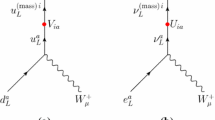Abstract
A recently presented concept, where, in the framework of parametrized relativistic quantum field theory, antiparticles are described consistently with negative frequencies, but positive energy density, is used to analyse the decay of neutralK-mesons, where the experimental results usually are interpreted as an evidence forCP-violation. In the theory presented the charge conjugation is antilinear, as in original Dirac theory, and theCPT-transformation is unitary. The Hamiltonian is indefinite, and changes sign under theCPT-transformation, since positive and negative eigenvalues are interchanged. As a result the eigenstates of the Hamiltonian are notCPT-eigenstates. The interference of positive and negative frequencies leads to a mixing ofCPT-eigenstates, as is observed in experiment. The study of a simple model system shows that the proposed mechanism of dynamical mixing offers an explanation for the experiments on theK 0−\(\bar K\) 0-meson system, with respect to both the observed mixing of eigenstates and the observed difference in the number of “CP-violating” events in the decays of the longer and shorter living neutralK-mesonsK L andK S . No symmetry violation of the theory needs be assumed.
Similar content being viewed by others
References
P. A. M. Dirac,Proc. Roy. Soc. (London) A117 (1928) 610;A126 (1929), 360;Proc. Camb. Phil. Soc. 26 (1930) 361. H. Weyl,Theory of Groups and Quantum Mechanics (Methuen, London, 1931).
H. Arzelies,Relativistic Point Dynamics (Pergamon, Oxford, 1972). N. A. Doughty,Lagrangian Interaction (Addison-Wesley, Sydney, 1990).
N. N. Bogolubov, A. A. Logunov, and I. T. Todorov,Introduction to Axiomatic Quantum Field Theory (Benjamin, London, 1975).
R. F. Streater and A. S. Wightman,PCT, Spin & Statistics, and All That (Benjamin, New York, 1963).
M. Reed and B. Simon,Methods of Modern Mathematical Physics Vol II: Fourier Analysis, Self-Adjointness (Academic, New York, 1975).
L. Hannibal,Int. J. Theor. Phys. 30, 1431 (1991).
L. Hannibal,Int. J. Theor. Phys. 30, 1445 (1991).
L. Hannibal,Rep. Math. Phys. 33 77 (1993).
L. Hannibal,Found. Phys. Lett. 7, 551 (1994).
E. C. G. Stueckelberg,Helv. Phys. Acta 14, 322, 588 (1941);15, 23 (1942).
R. P. Feynman,Phys. Rev. 74, 939 (1948);80, 440 (1950).
J. Schwinger,Phys. Rev. 82, 664 (1951).
L. P. Horwitz and C. Piron,Helv. Phys. Acta 46, 316 (1973).
J. R. Fanchi,Phys. Rev. D 20, 3018 (1979).
L. Hostler,J. Math. Phys. 21, 2461 (1980);22, 2307 (1981). R. Kubo,Nuovo Cimento 85A, 293 (1985). M. Pavšič,Nuovo Cimento 104A, 1337 (1991).
J. R. Fanchi,Found. Phys. 23, 487 (1993); J. R. Fanchi,Parametrized Relativistic Quantum Theory (Kluwer, Dordrecht, 1993), and references therein.
J. P. Aparicio, F. H. Gaioli, and E. T. G. Alvarez,Phys. Rev. A 51, 96 (1995);Phys. Lett. A 200, 233 (1995).
L. P. Horwitz, R. I. Arshansky, and A. C. Elitzur,Found. Phys. 18, 1159 (1988).
L. P. Horwitz,Found. Phys. 22, 421 (1992).
D. M. Greenberger,J. Math. Phys. 11, 2329, 2341 (1970);J. Math. Phys. 15, 395, 406 (1974); A. Kyprianidis,Phys. Rep. 155, 1 (1987).
D. Saad, L. P. Horwitz, and R. I. Arshansky,Found. Phys. 19, 1125 (1989).
J. E. Johnson,Phys. Rev. 181, 1755 (1969).
L. P. Horwitz and R. Arshansky,J. Phys. A: Math. Gen. 15, L659 (1982).
G. C. Hegerfeldt,Phys. Rev. D 10, 3320 (1974);Phys. Rev. Lett. 54, 2395 (1980).
G. C. Hegerfeldt and S. M. N. Ruijsenaars,Phys. Rev. D 22, 377 (1980).
A. S. Wightman and S. S. Schweber,Phys. Rev 98, 812 (1955); J. D. Bjorken and S. D. Drell,Relativistic Quantum Fields (McGraw-Hill, New York, 1965). C. Itzykson and J. B. Zuber,Quantum Field Theory (McGraw-Hill, New York, 1980).
S. Gasiorowicz,Elementary Particle Physics (Wiley, New York, 1966), Chap. 1.
S. Weinberg,Gravitation and Cosmology (Wiley, New York, 1972), Chap. 2, Sec. 13.
G. D. McFall and P. F. Zweifel, “The EPR paradox revisited: Locality, independence, interaction and hidden variables,” presented in Workshop on Advances in Physics, Dacca, Bangladesh, Jan. 15–19, 1990.
J. H. Christensen, J. W. Cronin, V. L. Fitch, and R. Turlay,Phys. Rev. Lett. 13, 138 (1964). L. K. Gibbons et al.,Phys. Rev. Lett. 70, 1199 and 1203 (1993).
Particle Data Group, L. Montanet et al.,Phys. Rev. D 50, 1173 (1994) and references therein.
V. Barmin et al.,Nucl. Phys. B247, 293 (1984). L. Wolfenstein,Ann. Rev. Nuc. Sci. 36, 137 (1986).
E. D. Commins and P. H. Bucksbaum,Weak Interactions of Leptons and Quarks (Cambridge University Press, Cambridge, 1983).
J. L. Rosner, “Heavy quarks, quark mixing and CP violation,” inTesting the Standard Model, M. Cvetič and P. Langacker, eds. (World Scientific, Singapore 1991), p.91, and references therein.
M. Kobayashi and T. Maskawa,Prog. Theor. Phys. Japan 49, 652 (1973). J. Ellis, M. K. Gaillard, and D. V. Nanopoulos,Nucl. Phys. B 106, 292 (1976).
L. P. Horwitz, C. Piron, and F. Reuse,Helv. Phys. Acta 48, 546 (1975).
A. Arensburg and L. P. Horwitz,Found. Phys. 22, 1025 (1992).
J. D. Bjorken and S. D. Drell,Relativistic Quantum Mechanics (McGraw-Hill, New York, 1964).
E. Wigner,Ann. Math. 40, 149 (1949). M. A. Naimark,Linear Representations of the Lorentz Group (Pergamon, New York, 1964).
H. Quinn, in Ref. [31], p. 1632, and references therein.
T. T. Wu and C. N. Yang,Phys. Rev. Lett. 13, 380 (1964).
T. D. Lee, R. Oehme, and C. N. Yang,Phys. Rev. 106, 340 (1957).
V. F. Weisskopf and E. P. Wigner,Z. Phys. 63, 54 (1930);65, 18 (1930).
K. Igi and S. Ono,Phys. Rev. D 33, 3349 (1986).
Author information
Authors and Affiliations
Rights and permissions
About this article
Cite this article
Hannibal, L. CP non-violation in neutral K-meson decay: A non-standard explanation. Found Phys Lett 8, 309–326 (1995). https://doi.org/10.1007/BF02187812
Received:
Revised:
Issue Date:
DOI: https://doi.org/10.1007/BF02187812



